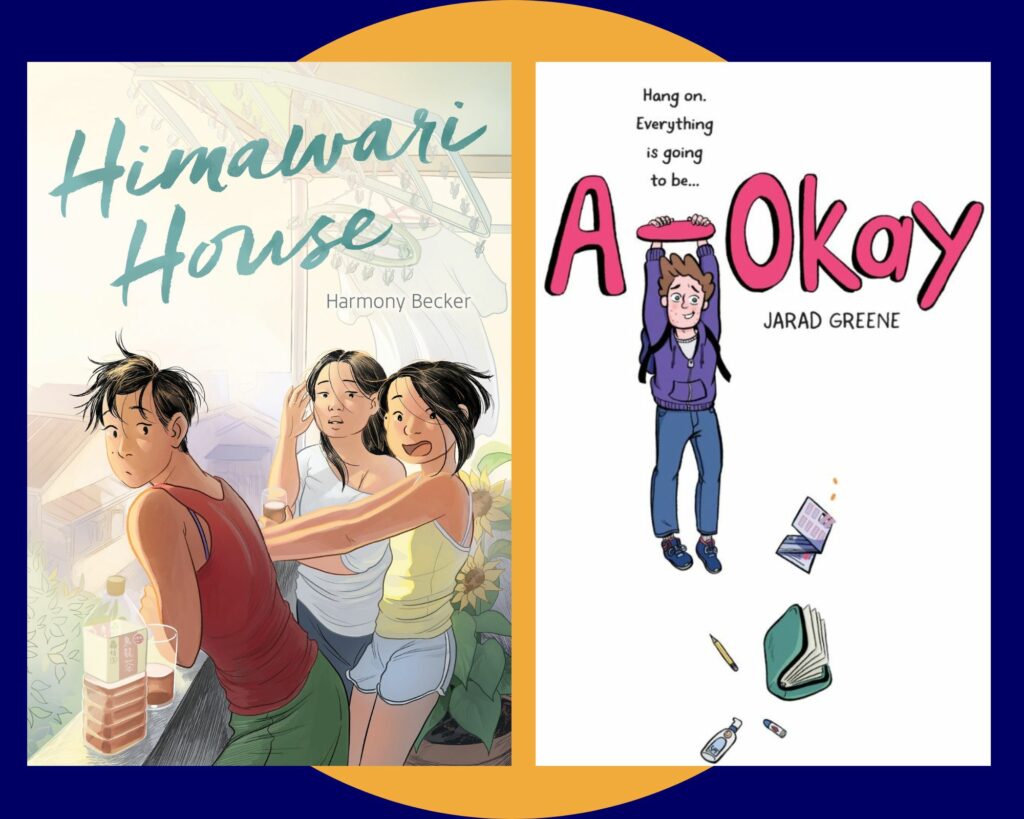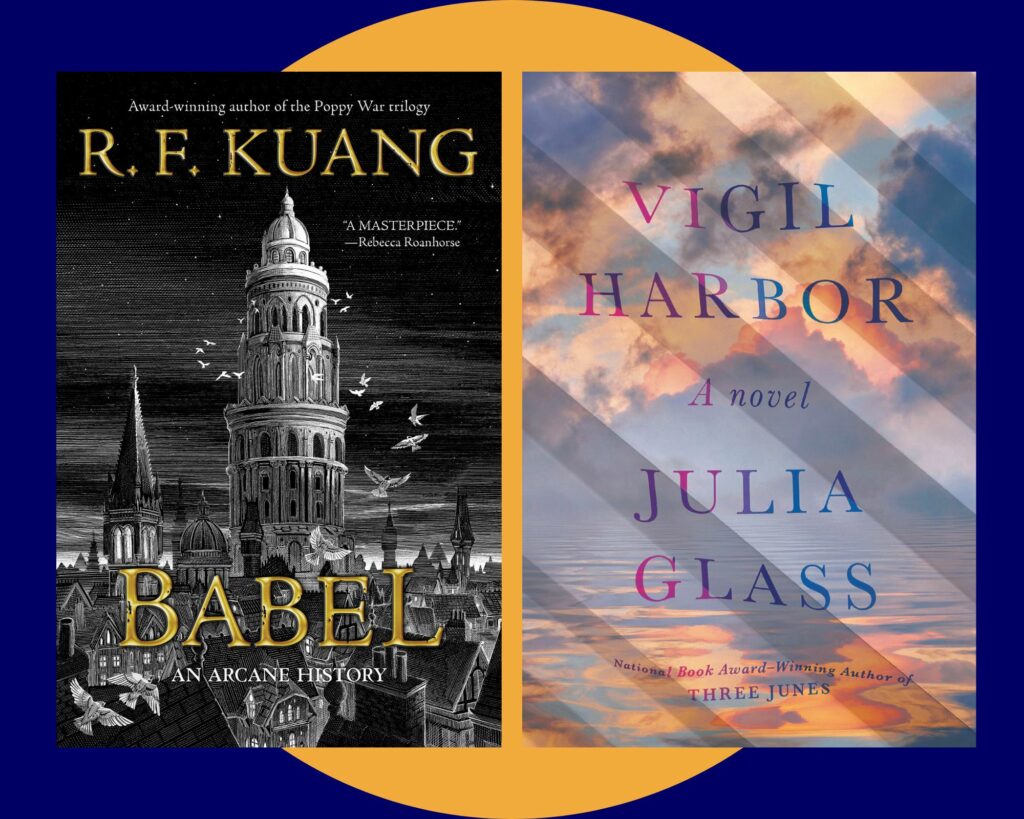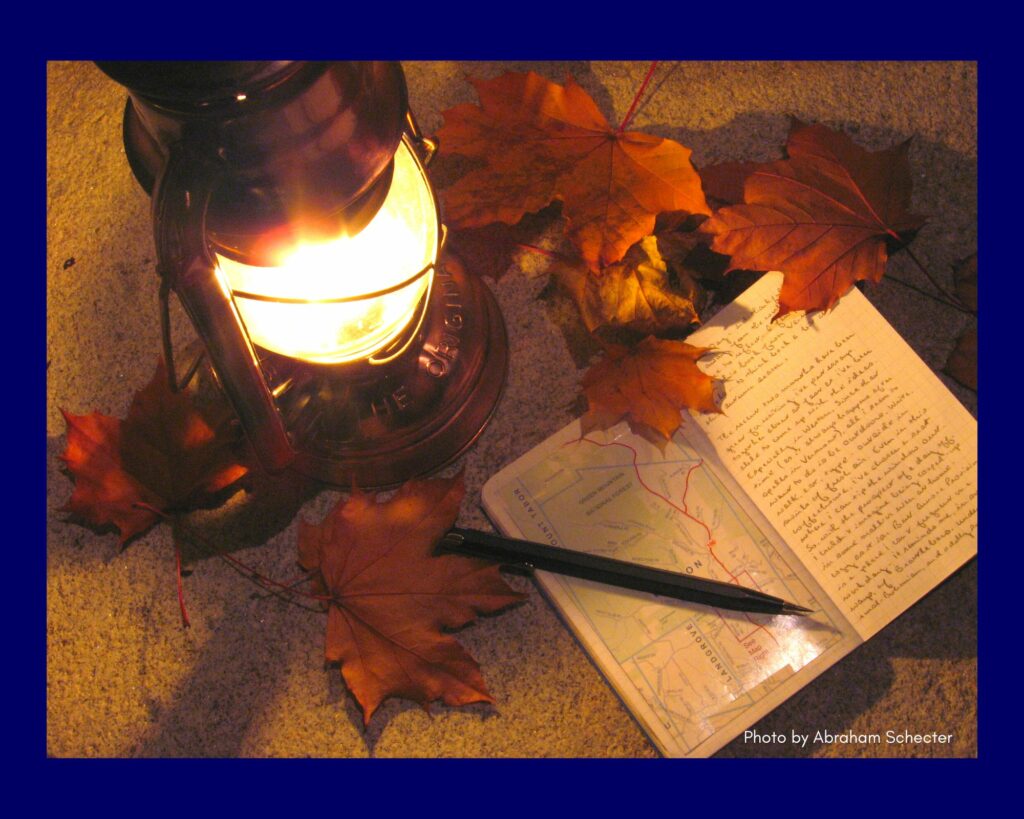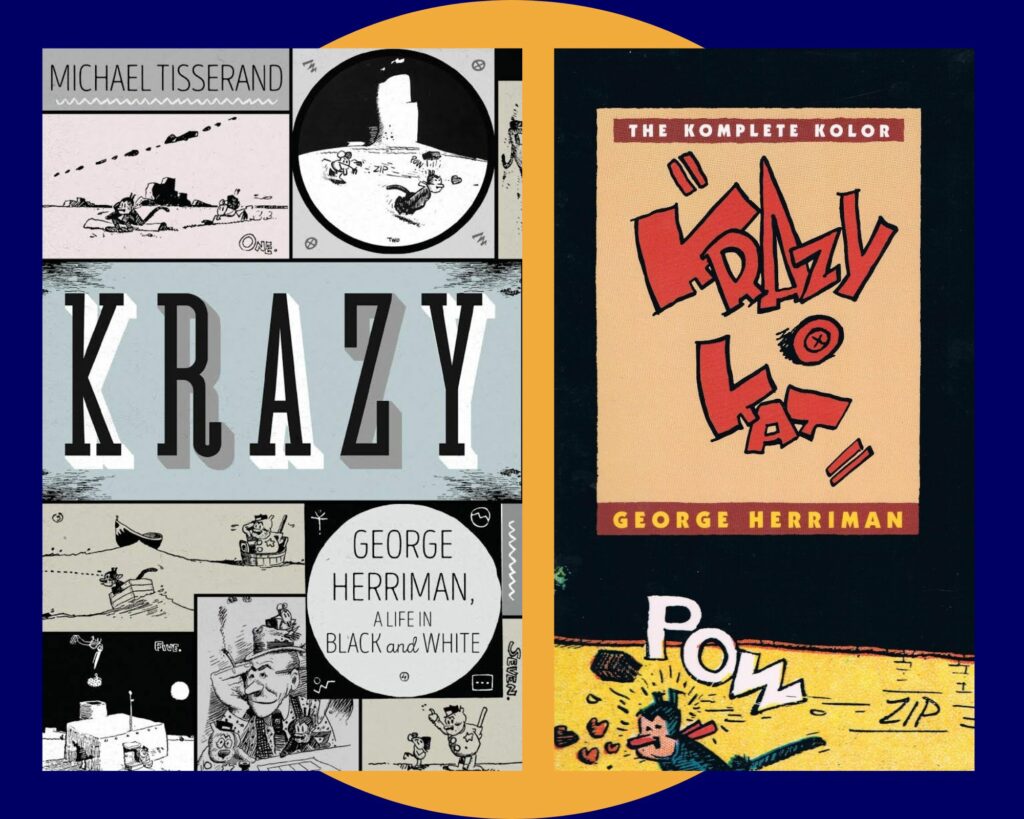Long Nights, Bright Books: Our Staff Picks
Snow has fallen in Maine, and we’re all tilting further from the sun, but no fear: the library is here for you. We have plenty of wonderful new books, audiobooks, eBooks, movies and more to brighten short days and long nights.
Have you seen Daniel Minter’s illustration exhibit in the Lewis Gallery? If you borrow the new picture book Blue: A History of the Color as Deep as the Sea and as Wide as the Sky, you can find his beautiful illustrations of Nana Ekua Brew-Hammond’s story of blue, too.
Looking for a great graphic novel? Try Una’s staff pick, Everything is Beautiful and I’m Not Afraid.
Have a big pumpkin pile that you need to put a dent in? You can find a herring-and-pumpkin (!) pot pie recipe inspired by Kiki’s Delivery Service in Studio Ghibli: The Unofficial Cookbook.
Excited about Morgan Talty getting shortlisted for the 2023 Andrew Carnegie Medal for Excellence in Fiction? Get on the list for Night of the Living Rez here.
Read on for our staff picks! We talk about new books from Indigenous authors as well as new poetry, the brilliant lives of octopuses, journaling in the great outdoors, the legacy of a famous cartoonist, the joys of black-and-white movies, and more.
Vicky’s Picks
November is Native American Heritage Month, so it seems like an apt time to highlight a couple great recent middle-grade books by Native authors.
Rez Dogs, by Abenaki storyteller and author Joseph Bruchac, is a free-verse gem that takes readers to the Penacook reservation in spring of 2020, when Boston schoolgirl Malian’s visit with her grandparents is unexpectedly lengthened by the Covid-19 lockdown. There she struggles with remote school due to unreliable WiFi but deepens her understanding of her family and Native heritage through her grandparents’ stories. It’s a tender vehicle for harsh truths, and readers will emerge, like Malian, with a profound appreciation for her culture.
Switching from realism to fantasy, Sisters of the Neversea is a joyful revision of Peter Pan by Cynthia Leitich Smith, a Muskogee Creek author who grew up loving the J.M. Barrie classic though she winced at the portrayal of Neverland’s Indians. Lily and Wendy are stepsisters, Lily’s Creek mother having married Wendy’s white English father. As career tensions threaten their parents’ marriage, the girls find themselves separately taken to Neverland, where adventures aplenty ensue. Thanks to the ubiquity of the Peter Pan story, children don’t need to have read the original Barrie to see how Smith plays with its plot and characters to deliver a heartfelt tale that honors the cozy thrills of its inspiration while giving its diverse cast of characters the respect they deserve.
Read and share them now or anytime during the year—they’re both thoroughgoing delights, whatever the month.
Emily’s Picks
Our family has recently enjoyed two picture books: one an excellent nonfiction book that explores what it would have been like to live during the Plimoth Thanksgiving. Meanwhile Keepunumuk discusses the same topic through a very different lens, with a Wampanoag grandmother explaining to her grandchildren how Weeâchumun (corn) and her sisters Beans and Squash saved the newcomers in their first years.
I have just devoured the third book in the Misewa Saga, The Stone Child. This middle grade series is written by David Robertson (Norway House Cree Nation) and began with the captivating book The Barren Grounds. Morgan and Eli are two Cree children who have been taken from their families and are living in the same foster home in Winnipeg. They both feel angry, disconnected, and annoyed about their earnest foster parents’ attempts to connect. Then the two discover a portal into another world in their attic—a world called Askí, where they meet giant talking animals and learn of the dangers they face in a land where it is perpetually winter. It’s a brilliant series that blends fantasy adventures and reality. Morgan and Eli learn and share traditional Cree words and ways to survive, growing closer over the years they spend in another realm. Highly recommended reading as we head into a snowy winter world of our own!
Now I’m excited to dive into another story, Man Made Monsters by Andrea Rogers (Cherokee Nation). It’s a young adult horror book that follows an extended Cherokee family across the centuries from 1830s and into the future, with illustrations by the artist Jeff Edwards (Cherokee Nation). I’m bracing myself for all of the killer magical creatures and jumping at every sound in the house.
Cindy’s Picks
I have two new middle grade chapter books that I am very excited to recommend this month!
“Dear Susan B. Anthony:
I have very bad news for you. You’re dead. Really dead. Like, over one hundred years dead. Like, right now, you are dust and bones in the cemetery of your old hometown, Rochester, New York.
Sorry.
You are probably thinking, what the heck? If I am dead, why are you writing to me?”
In Susie B. Won’t Back Down by Margaret Finnegan, Susie B’s personal hero is Susan B. Anthony. Susie B. is also running for student council president, and she thinks that she has the race in the bag when an amazing new candidate enters the race. At the same she discovers her hero might not have been as great as some versions of history suggested she was—and Susie B. realizes she has some very tough decisions to make.
The second book is called The Secret Battle of Evan Pao by Wendy Wan-Long Shang. Evan Pao is hoping for a fresh start when he and his mother and sister move from California to Haddington, Virginia. They are hoping to keep the secret of his father’s notoriety.
In the small Southern town, Evan makes a lot of friends, but he is also bullied at Battlefield Elementary by another student because he is Chinese American—one boy, Brady Griggs, is determined to make Evan’s life miserable. Evan also finds a unique way to make himself a part of the school’s annual Civil War celebration, but it backfires terribly. How will Evan figure out how he fits into his country’s past and how will he help shape its future? Read this book to find out!
Carly’s Picks
This month, I’m excited to recommend three great graphic novels from the Teen Library.
In Harmony Becker’s Himawari House, main character Nao was born in Japan but grew up in the United States. Perceived as “different” and “other,” she forgoes her first language and Japanese cultural traditions in an effort to fit in. By age eighteen, though, Nao misses these parts of herself—so she decides to return to Japan, the place she considers her true home, for a gap year after high school. The story that follows is a thoughtful, beautifully rendered exploration of cultural identity, friendship, family and found family, and growing up.
In A-Okay by Jarad Greene, eighth grade brings a lot of changes for Jay: shifting friend groups, questions about his self-identity, and a case of acne that only responds to a harsh medication. Readers follow Jay throughout both the school year and the course of his acne treatment (and its accompanying side effects). In the Teen Library, we’ve seen that comics and graphic novels like A-Okay can be an approachable way for young and grown readers alike to understand complex health topics. Check out our Teen list, Graphic Medicine, if you’re looking for more stories where health and art intersect.
Finally, the graphic memoir, Victory. Stand!, celebrates the life of Olympic gold medalist Tommie Smith. Readers learn about his rise to become a world-class runner alongside the emergence of his identity as an activist for racial justice, which culminated on the Olympic podium in 1968. After receiving gold and bronze medals respectively, Smith and teammate John Carlos raised their fists in a Black power salute to protest the treatment of Black people in the United States. Their action was met with outrage from the Olympic committee and anger from white Americans and journalists who felt the protest was distasteful. Yet time has only increased the widespread recognition of Smith and Carlos’ bravery. Smith’s story—co-written by Derrick Barnes and illustrated by Dawud Anyabwile—is a timely reminder of the longstanding tradition that ties athletics with activism.
Becca’s Pick
Babel: An Arcane History might just be my favorite book published in 2022. It’s the late 19th century in Oxford, and a diverse group of students begin their studies at the Royal Institute for Translation. In the giant tower known as Babel, they will learn the art of silver working, or finding “match pairs” of words in different languages that activate the silver in ways that drive industrial growth. When some of the students are invited to join a separatist group of translators working against Babel, they must decide if their loyalties lie with the British Empire or their countries of origin.
There is so much packed into Babel‘s 500 pages. We’ve got issues of race, class, imperialism, and protest. It invites more than one moral quandary and does not offer easy answers. It also contains stunning fantasy elements and a chaste queer love story! This is dark academia at its finest, and I found myself regularly staying up way past my bedtime to read 40-50 pages at a time. If you’re a fan of student stories like The Secret History, descriptive magic like Jonathan Strange & Mr. Norrell, or the alchemic fantasy of The City of Brass, then this book is for you.
Stephanie’s Pick
Vigil Harbor by Julia Glass is terrific and scary in a very real way. It’s not a traditional mystery, but I couldn’t put it down. It is set mostly in a very believable future, maybe 10 years from now, in a wealthy liberal coastal village like Marblehead. Perfectly drawn characters deal with climate change, political violence, new disease, lost love and the mysteries of the sea. I found it compelling enough to merit an award, but I’m not on any committees. I figure you can’t ask for more than a dramatic plot with real characters (well, mostly real), who make you think about that heavy list above. I loved it and actually worried about these people and us.
Marie’s Pick
Please read Laziness Does Not Exist by social psychologist Dr. Devon Price. It is a thoughtful, accessible takedown of capitalism’s demand for constant productivity; a plea to slow down for the sake of our humanity. Another world is possible, wherein doing “nothing”—resting, playing, loving, daydreaming, being—is the most valuable thing we can do.
Abraham’s Picks
“An observing spirit can thus derive pleasure from the most trivial circumstance.” —Thomas Cogan, from Treatise on the Passions and Affections of the Mind (1813)
The Autumn season—still temperate enough for extended walks, hikes, and enjoyment outdoors—inspires creative musing and expression. Whether you’re in the city, by the ocean, or in the woods, there can be opportunities to observe and appreciate the light and colors of the season. In his journals, Henry David Thoreau wrote in detail about how he saw autumn and what his observations brought to mind. Here are a few books to help supply journal-writing ideas, with prompts and anecdotes: The Pocket Muse (by Maine’s own Monica Wood!), Creative Journal Writing, Keeping a Nature Journal, and The Journal – Henry David Thoreau.
Eileen’s Pick
The sky, on my early morning commute today, was soft black. At one magical moment, a small but mighty white light streaked across it. Left to right, east to west, it fell in an arc, at a precise trajectory to be swallowed by the treetops.
I think of November as the black-and-white month. Mostly, the palette falls between the two, but I will refrain from saying that it is shades of gray, of any quantity. Our bird neighbors are chickadees, nuthatches, titmice, woodpeckers, matching the landscape and the light. Stark and beautiful, trees’ silhouettes counter each other, birch against hemlock against oak against pine against birch and on and on. Color leaks from familiar shapes and granite soaks it up to be released next year in a springtime frenzy. For now, though, black and white not only suffices, but fulfills. That is the time we are in and it is soulful and satisfying and an opportunity to appreciate subtle contrasts and myriad tones and shades. Black and white can be many hued, startling or calming.
Or just entertaining. And this is where I finally, finally…good gravy, you thought I’d never get to my staff pick, didn’t you?…make a case for my November Pick. How about a really good black-and-white movie to cheer you through a dark couple of hours? Something visually neutral, yes, but supersonically fast-paced to prevent dozing off with a tell-tale trail of drool working its way floorward. Hollywood studio written all over it? You bet. Hollywood, in a good way, that is.
Friends, I nominate His Girl Friday as an exceptionally satisfying diversion from anything you need to be diverted from. Land yourself with Cary Grant and Rosalind Russell for this 1940 Howard Hawks directed re-do of the “The Front Page” by Charles MacArthur and Ben Hecht. Russell is outstanding, as is Grant. I challenge you to keep up with the rapid-fire repartee… if you can follow closed-captioning at speed, you may actually catch it all. Maybe. But don’t count on it.
For me, black and white doesn’t get better than this. November is a perfect time for it, and for that and so much more, I give thanks.
Rachael’s Pick
I read Mother Brain by local writer Chelsea Connaboy last month and really enjoyed it. After bearing witness to my own brain changing through pregnancy and raising children it was fascinating to make connections between what happened and why it was happening.
Jim’s Picks
A month for octopuses! I read two fiction books on the theme of super-intelligent octopuses: The Mountain in the Sea by Ray Nayler and Remarkably Bright Creatures by Shelby Van Pelt. If you eat seafood, you may alter your habits after reading.
Elizabeth’s Picks
As the days get colder and the nights close around us, my stacks of books begin to teeter ever higher.
“I love the dark hours of my being / for they deepen my senses.” Pádraig Ó Tuama quotes Rilke in Poetry Unbound: 50 Poems to Open Your World. I’ve followed Pádraig Ó Tuama’s gentle, insightful discussions of poetry on the podcast Poetry Unbound since I saw him read in a program with Portland Poet Laureate Maya Williams last year. Here he wings through and responds to the work of contemporary favorites—Kaveh Akbar and Aracelis Girmay, Hanif Abdurraqib and Ilya Kaminsky, as well as poets who are new to me— like Gregory Pardlo, Joy Ladin, and Paul Tran, who writes “There’s a dark so deep beneath the sea the creatures beget their own / light.” These poems resonate through all the hours after sunset.
An Irish novella: Claire Keegan’s writing is luminous as ever. Foster is a quiet, tender tale that haunts in all it says and does not say.
More poetry! It feels like I’ve been waiting a long time for Franny Choi’s The World Keeps Ending, and the World Goes On. It’s here, along with the immediacy and clarity of her voice: “Like everyone else, I want a storm I can dance in. / I want an excuse to change my life.”
Making Love With the Land by Joshua Whitehead (a Two-Spirit, Oji-nêhiyaw member of Peguis First Nation) has also arrived in time for winter: “I remember us this way, two Prairie queers celebrating the generosity of an accepting land and a blanket of family.”
Aaron’s Picks
Cartoonist George Herriman, creator of the genre-defining-and-defying Krazy Kat comics that ran in American newspapers from 1913 to 1944, lived a life nearly as unlikely as the absurd, missed-connection adventures of Krazy and their pals’ lives in the vividly-drawn Southwest desert locale where the strip takes place. [Note that throughout his life Herriman declined to define Krazy Kat as either male nor female, and often used they/them pronouns to describe them.] The blockbuster revelation that opens Michael Tisserand’s biography of Herriman—a fact widely acknowledged only after his death—is that Herriman was a Black man who spent the latter part of his childhood and his entire adult life “passing” as white. This in itself doesn’t make Herriman unique. Passing was common in the 19th and early 20th century and motivations for doing so quite plain. But the particular route Herriman travelled from the relatively affluent Creole community of post-Civil War New Orleans to turn-of-the-century and early-mid-century New York, Los Angeles, and Arizona offers further complexity to narratives of race and community across eras and a continent.
Tisserand tells the complex story with sensitivity. Where certain parts of the book may get bogged down in a sequential listing of the known events of Herriman’s life, there is always reference to the evolution of Herriman’s style and craft, to notable strips or panels he drew, and a wealth of background on the development of American cartooning and newspaper comic strips.
The comic strips themselves, and especially the fully realized full-page, full-color Krazy Kat strips as seen in The Komplete Kolor Krazy Kat, are often referenced by later cartoonists including Charles Schultz, Will Eisner, and Bill Watterson (who wrote the anthology’s foreword) as an inspiration and as an origin point of many innovations in comic art.
Not just a predecessor or step on the way to modern cartoons, though, Krazy Kat is closer to its own genre, an absurd, slapstick, tragicomic, existential roller coaster often more reminiscent of Samuel Beckett than Fontaine Fox (Toonerville Trolley) or even Watterson and other more recent artists. Herriman’s visual style is stunning, the Arizona desert rendered in stark colors and shapes bordering on abstract art. Krazy Kat, Ignatz Mice, and the rest of the regular and irregular characters are as dynamic in their motion and action as Looney Tunes, but without feeling polished or sanitized at all. The visual and spoken language of Herriman’s characters is an unexpected combination of patois and pidgin English, Shakespeare and other literary riffs, references to Greek philosophy and European and American art, subtle (and not-so-subtle) nods to race and racism, all clearly born of an intensely personal landscape of humor and aesthetics.
That Krazy Kat ran in major newspapers at all perhaps speaks to a past with a wider-open field for all kinds of art and writing, a world with a growing, or at least thriving, print culture compared to today’s shrinking major print media. Regardless of whether today’s newspaper cartoonists list him as an inspiration, the places where Herriman’s spirit truly lives on today are mostly in the underground and independent comic and zine communities. Whatever their other qualities, there’s little chance of running into something as beautiful—or as funny—in the pages of the Portland Press-Herald or the Bangor Daily News today. Lucky for us, a great number of Herriman’s strips survive and have been collected in published volumes, and a biography suitable to the subject has been written.
Thanks for reading! To check out a full catalog list of all the titles we mention here, see: Long Nights, Bright Books: Our Staff Picks.
If you’re looking for more reading ideas, that is our very favorite thing! Check out our Your Next Great Read service for readers of all ages, or simply reach out to our staff at readersadvisory@portlib.org for your own personalized booklist of reading suggestions.
posted: , by Elizabethtags: Library Collections | Recommended Reads | Adults | Seniors | Readers Writers











